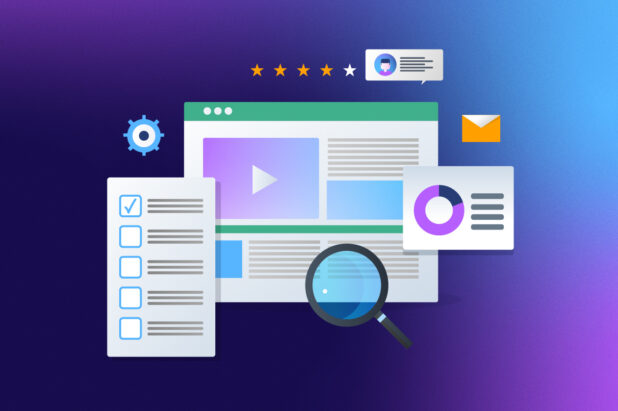If you’re churning out content but not seeing a bump in search-driven traffic, it’s likely time to recalibrate your strategy with a content gap analysis. Content gaps are those missing pieces that keep your audience from finding what they need — and keep your site from ranking where it should.
In this guide, we’re breaking down a step-by-step process to conduct an SEO content gap analysis, to help you find the opportunities you didn’t even know you were missing. Once you know what’s lacking, you can fire up the creative engines and produce a range of content that drives better results.
What is a content gap analysis?
A content gap analysis is the process of evaluating your existing content to identify missing topics, themes, or pieces of information that your audience needs but isn’t currently getting from you. To put it another way: It’s the method of pinpointing where your content falls short in delivering value, whether that’s due to outdated information, lack of depth, or even missing topics that your competitors are covering.
This analysis helps you uncover valuable opportunities to create new content that resonates with your audience. While it’s true that this process helps appease the Algorithm Overlords by better aligning your content with user intent, the bigger win comes from getting your audience to click through to your site and position your brand as the go-to resource in your industry.
How to conduct a content gap analysis
Step 1: Define your target audience and their journey
You can’t find gaps if you don’t know what your audience needs. To even begin this process, you need a clear understanding of who you’re talking to, what they’re searching for, and how your content can guide them along every stage of their journey. This first step will help you get into the mindset of your audience and uncover where your content strategy needs a boost.
Tactical tips to get started:
- Create detailed audience personas. These personas should be more than just the basics — dig into pain points, motivations, and buying triggers. The more specific you get, the better you’ll be at aligning your content.
- Map out the buyer’s journey. Visualize the path from awareness to decision-making. Identify key touchpoints where your audience engages with your brand or searches for solutions.
- Spot the gaps. Look for stages in the journey where your audience struggles, gets confused, or needs more information. These are your opportunities to create content that answers their questions or solves their problems.
These preliminary steps help you spot gaps in your current strategy and create a more audience-focused content roadmap.
Step 2: Perform keyword research with intent in mind
Not all keywords are created equal. Targeting the right ones is crucial to creating SEO content that aligns with your audience’s search intent. When your content matches what users are actually searching for, it stands a much better chance of getting noticed, clicked, and engaged.
Tactical tips to get started:
- Use analytics tools to identify opportunities. Leverage search analytics platforms to explore keyword variations, search volumes, and competition levels. Keep an eye out for terms your competitors are missing or underutilizing.
- Focus on user intent. Think about the why behind each search. Is the user looking for information, exploring options, or ready to take action? Align your keywords with these intent types to better target and engage your audience.
- Find gaps in your current content. Analyze the overlap between your keyword list and existing content. Are there keywords you’re not addressing fully or at all? These gaps are prime opportunities to create new, targeted pieces.
Prioritizing keywords based on intent and opportunity strengthens your SEO strategy and ensures your content directly addresses your audience’s needs and desires in their searches.
Step 3: Audit your existing content
You need to know what you’ve got to see what’s missing. An audit helps you understand your content’s current state, showing you what’s performing well and where improvements are needed.
Tactical tips to get started:
- Use a content inventory tool. Use content auditing tools or services to gather a complete inventory of your content. These tools will help you organize and analyze everything in one place.
- Assess for weak points. Look for content with low engagement, poor ranking, or high bounce rates. This could be a sign of a mismatch between your content and audience expectations.
- Identify outdated information. Check for content with old stats, expired links, or information that’s no longer relevant to your industry. Declining performance trends are often a sign of aged content. Update or replace outdated pieces to keep your insights fresh and reliable.
- Spot opportunities for refreshes. Sometimes, a piece of content just needs a new angle or a little more depth to make it more valuable. Identify articles that can be expanded or repurposed to better meet audience needs.
Conducting a thorough audit provides a clear understanding of your existing content’s strengths and weaknesses, paving the way for more strategic improvements and gap-filling efforts.
For more insights on what an internal website audit entails, check out What to Look For in an SEO Analysis of a Website.
Step 4: Analyze competitors’ content to identify missing opportunities
Understanding what your competitors are doing well (and where they’re falling short) is key to finding your own content gaps. Analyzing their strategies helps you identify opportunities to cover overlooked topics, fill in white space, or add a different point of view on a topic that’s resonating. Remember to focus on being strategic in where and how you compete, rather than simply copying.
Tactical tips to get started:
- Explore your competitors’ content libraries. Dive into competitor blogs, resource hubs, and other key areas to see what topics they’re prioritizing. Look at what they’re ranking for and the angles they’re taking.
- Evaluate performance metrics. Use analytics tools to analyze competitor content performance. Check for top-performing pieces and which keywords are driving their traffic.
- Identify gaps and opportunities. Look for areas where your competitors are missing the mark: questions they’re not answering, outdated information, or audience pain points they’re not addressing. These are prime spots for you to step in with better, more comprehensive content.
Keeping a close eye on the competition reveals areas where you can differentiate, outshine, or deliver what your audience is missing elsewhere. At TopRank, we develop keyword glossaries that show clients how their domain is ranking and how competitors are ranking for target terms at a glance.
Step 5: Prioritize your content opportunities
You’ve uncovered the gaps, now it’s time to prioritize the most valuable opportunities. The key is to focus on opportunities that align with your audience’s journey, have high discoverability potential, and present the best chance for your content to stand out.
Tactical tips to get started:
- Rank based on search volume and competition. Prioritize gaps that have a high search volume but low-to-moderate competition. These are often the quick wins that can drive significant results with less effort.
- Align with your audience’s journey. Revisit the buyer’s journey and audience personas you mapped out in Step 1. Focus on creating content that meets your audience’s needs at each key touchpoint. Is it easy for prospective customers to take incremental next-steps within your content ecosystem?
- Evaluate strategic alignment. Consider your overall business goals and how each opportunity aligns. Does it fit your brand messaging? Will it support your long-term SEO strategy?
- Plan with a content calendar. Organize your prioritized content opportunities into a content calendar to keep your strategy on track. Assign deadlines, set content goals, and ensure consistent execution to maximize your efforts.
Prioritizing your content opportunities ensures that you’re not just filling gaps but doing so with the most impactful and relevant content for your audience.
Ready to start closing those gaps?
Conducting an SEO content gap analysis is essential for uncovering what your audience needs and identifying what your competitors are missing. When you align your strategy with these insights, your content will better resonate with users and improve your overall SEO performance.
Explore the many ways TopRank Marketing can help you build a gapless SEO content strategy.



